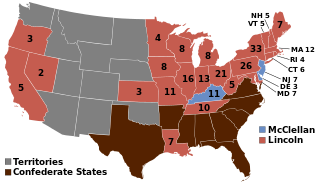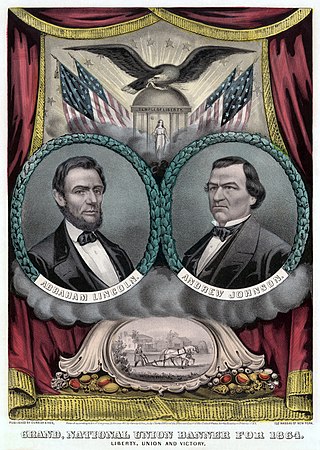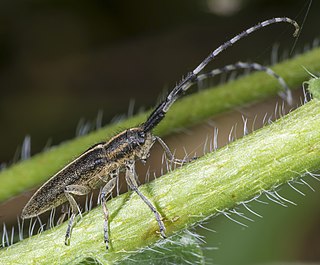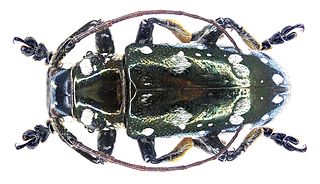
The 1864 United States presidential election was the 20th quadrennial presidential election. It was held on Tuesday, November 8, 1864. Near the end of the American Civil War, incumbent President Abraham Lincoln of the National Union Party easily defeated the Democratic nominee, former General George B. McClellan, by a wide margin of 212–21 in the electoral college, with 55% of the popular vote. For the election, the Republican Party and some Democrats created the National Union Party, especially to attract War Democrats.
The 1864–65 United States House of Representatives elections were held on various dates in various states between June 5, 1864 and November 7, 1865, in the midst of the American Civil War and President Abraham Lincoln's reelection. Each state set its own date for its elections to the House of Representatives. Members were elected before the first session of the 39th United States Congress convened on December 4, 1865, including the at-large seat from the new state of Nevada, and the 8 from Tennessee, the first secessionist state to be readmitted. The other 10 secessionist states had not yet been readmitted, and therefore were not seated.

The 38th United States Congress was a meeting of the legislative branch of the United States federal government, consisting of the United States Senate and the United States House of Representatives. It met in Washington, D.C. from March 4, 1863, to March 4, 1865, during the last two years of President Abraham Lincoln's first term in office. The apportionment of seats in the House of Representatives was based on the 1860 United States census. The Senate had a Republican majority, and the House of Representatives had a Republican plurality.

The National Union Party was the name used by the Republican Party and elements of other parties for the national ticket in the 1864 presidential election during the Civil War. Most state Republican parties did not change their name. The name was used to attract War Democrats, border state voters, and Unconditional Unionist, and Unionist Party members who might otherwise have not voted for Republicans. The National Union Party nominated incumbent Republican President Abraham Lincoln of Illinois and Democrat Andrew Johnson of Tennessee for Vice President. They won the Electoral College 212–21.

Lamiinae, commonly called flat-faced longhorns, are a subfamily of the longhorn beetle family (Cerambycidae). The subfamily includes over 750 genera, rivaled in diversity within the family only by the subfamily Cerambycinae.

The 1864 United States presidential election in California took place on November 8, 1864, as part of the 1864 United States presidential election. State voters chose five electors of the Electoral College, who voted for president and vice president.

The 1864 National Union National Convention was the United States presidential nominating convention of the National Union Party, which was a name adopted by the main faction of the Republican Party in a coalition with many, if not most, War Democrats after some Republicans and War Democrats nominated John C. Frémont over Lincoln. During the Convention, the party officially called for the end of the ongoing Civil War, the eradication of slavery and the adoption of the Emancipation Proclamation.

The 1864–65 United States Senate elections were held on various dates in various states. They occurred during the American Civil War and Abraham Lincoln's re-election. As these U.S. Senate elections were prior to the ratification of the Seventeenth Amendment in 1913, senators were chosen by state legislatures. Senators were elected over a wide range of time throughout 1864 and 1865, and a seat may have been filled months late or remained vacant due to legislative deadlock. In these elections, terms were up for the senators in Class 2.
Acanthocinini is a tribe of longhorn beetles of the subfamily Lamiinae. It was described by Blanchard in 1845.

The 1864 United States elections were held on November 8, 1864. National Union President Abraham Lincoln was elected to a second term, while the Republicans added to their majorities in Congress. The elections were held during the American Civil War. Lincoln would be assassinated shortly into his second term.

Agapanthiini is a tribe of longhorn beetles of the subfamily Lamiinae.

Pteropliini is a tribe of longhorn beetles of the subfamily Lamiinae.

Lamiini is a tribe of longhorn beetles of the subfamily Lamiinae.
Xenoleini is a tribe of longhorn beetles of the subfamily Lamiinae. It was described by Lacordaire in 1869.
Xenolea tomentosa is a species of beetle in the family Cerambycidae. It was described by Francis Polkinghorne Pascoe in 1864. It is known from Singapore, Malaysia, Andaman Islands, and Sumatra.

Xenolea asiatica is a species of beetle in the family Cerambycidae. It was described by Maurice Pic in 1925, originally under the genus Aeschopalea. It is known from Laos, India, Thailand, Japan, China, and Vietnam.
Xenolea collaris is a species of beetle in the family Cerambycidae, and the type species of its genus. It was described by James Thomson in 1864. It is known from Indonesia, Taiwan and the Philippines.
The 1864–65 New South Wales colonial election was for 72 members representing 60 electoral districts. The election was conducted on the basis of a simple majority or first-past-the-post voting system. In this election there were 8 multi-member districts returning 20 members and 52 single member districts. In the multi-member districts each elector could vote for as many candidates as there were vacancies. 11 districts were uncontested.










